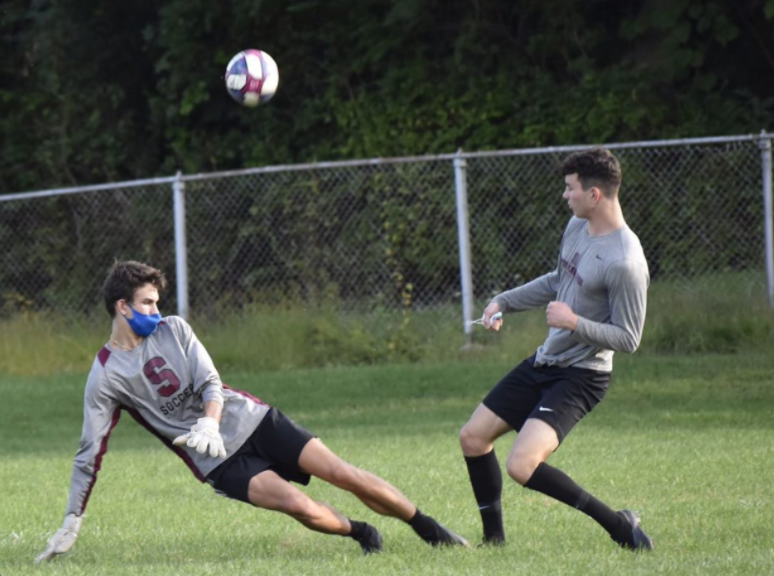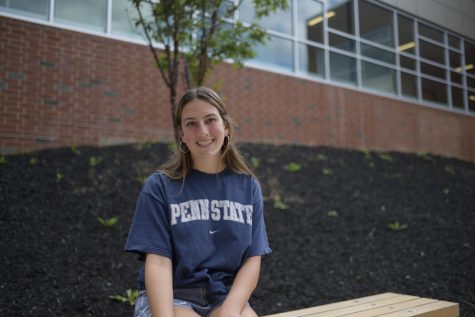A Season Like No Other: How State High Athletics Have Adapted to COVID-19
A soccer practice at Community Field in State College, PA, taken Wednesday, Aug. 9, 2020. Senior Ty Price shoots the ball at Sasha Mohoruk, senior and varsity goalie.
September 13, 2020
COVID-19 has created many questions, such as what would happen with fall sports. Many of these teams had the challenge of figuring out the inevitable precautions they would have to take to keep practices safe. How would they be able to change their routine practices? Even as COVID-19 cases increased and the hope for a season grew smaller, State High athletes and the athletic department never gave up hope that they would have a season. Everyone involved had been extremely dedicated and had worked very hard to create procedures and rules that could be adapted to fit the current situation, in addition to keeping athletes and coaches as safe as possible. All of that hard work paid off though, with the school board voting to allow a fall sports season at their meeting on Sept. 2.
Despite these circumstances, the athletes of State High continued to stay motivated and found creative and safe ways to hold practices. While many sports have different protocols, the most emphasized across the board are five simple steps: mask up when coming on and off the field, wear a long-sleeved shirt to practice, sanitize your hands regularly, distance your personal bag away from others, and fill out an online COVID-19 self-assessment before coming to practice.
Football
As one of the most anticipated, funded, and student attended sports, the football team was forced to immediately find ways to adapt if they wanted to have a season. Typically, football is a sport that has a lot of physical contact, such as tackling and passing a ball with your bare hands. Despite some challenges, the football team, coached by Matt Lintal, Mark Baney, and countless other assistant coaches, found ways to facilitate contact limited practices. Everyone is masked at all times, stays 6ft apart, wears long sleeves to minimize skin to skin contact, uses lots of sanitizer, and takes part in contactless drills, such as ones involving large bags that help with defensive technique.
“I really do think that staying 6ft apart is one of the most challenging things yet, especially since football is such an up-close and in your face sport,” said Xander Cox, a junior on the football team.
Girls’ Volleyball
Volleyball has been an extremely challenging sport to change, most notably due to the fact that the game is played inside, on a court with close proximity to other players. During the summer, many of the athletes were able to practice outdoors, but with colder weather, that becomes less of an option. The team shows up masked and carrying sanitizer. Additionally, the volleyballs must be sanitized and many drills must be adjusted to meet social distancing requirements.
“The most challenging part has been the social distancing. The girls are very much accustomed to high-fiving, embracing, and generally being in close quarters,” head coach Chad Weight said.
Boys’ Soccer
Soccer may have been one of the easier fall sports to revise, as it is played outside and typically at a distance, unless pressing to get the ball. There weren’t many new rules other than the four mentioned above. Even if there weren’t many things changed in soccer, adjusting to new procedures was challenging in its own ways.
“My voice doesn’t travel too well under a mask to a group of players spread over a big area, so delivering program rationale is tricky. Conveying the importance of our protocols to the players is a big part of ‘coaching,’” head coach Danny Orton explained.
Girls’ Soccer
Girls’ soccer is very similar to boy’s soccer, with the team following the new simple procedures, in addition to creating 3 “pods,” which are smaller teams the girls practice together in while rotating to different stations. These pods help to limit closeness, in addition to creating an easier way to contact trace individuals if necessary. Despite the uncertainty, the team has kept a very positive attitude throughout the whole thing.
“Other than our social distancing, wearing masks, and different practices format, you would never know we were going through uncertain times in athletics watching them practice. I love their spirit and I love working with this group.” Bates said. “Everything logistically is different. The only thing that’s the same is the girls’ spirit and enthusiasm.”
Field Hockey
The field hockey team has not only had the challenge of adapting to the new rules, but also the challenge of finding a new head coach after their previous head coach, Bethany Mink, moved last year. Luckily, Sharon Herlocher stepped up for the position and spent the summer running practices. Besides following the protocol, the team also has lots of sanitizer on hand. While not being allowed to scrimmage, the team breaks down into smaller groups and works on socially distant offensive and defensive drills. While these drills are effective, not having vital scrimmages is challenging.
“I wish we could scrimmage. Skills training is great, but using a mixture of skills with competing is what motivates and engages all,” Herlocher said.
Girls’ Tennis
Even while being confined to a small court, the tennis team still has the ability to practice singles and socially distanced doubles matches. The team has lots of similar protocols to many other sports, such as socially distanced warmups, small group instruction, and lots of sanitizer. Additionally, UV lights are used on equipment for sanitation, players use their own balls, and the team tries to practice contactless ball pickup with separate buckets.
“Practices are pretty much the same as they were before-with the exception of COVID paperwork-because tennis is a naturally socially distanced sport,” head coach Jane Borden said. “Our team always has natural leaders and every year they step up and do what is expected of them. I’m very fortunate to have the opportunity to work with such an amazing group of student-athletes and coaches.”
Boys’ and Girls’ Cross Country
While cross country may be another sport that seems easy to adapt, there are still many challenges present in both the boys and girls cross country teams. The teams follow the same guidelines as other sports, but instead of running in packs, like many usually see them, they have been encouraged to run spaced out from one another. Teams don’t share equipment and they wear masks at all times, except for when the girls’ team takes them off for longer runs.
“This has been a difficult transition considering the fact that it is very hard to breathe and take in oxygen the same way when you are running compared to just walking around or doing normal daily activities,” junior Trent Dinant said.
Even though the plan is set, the fact that things can change so quickly is definitely a challenge for everyone.
“I’d say the most challenging part has been the uncertainty. While we’re so excited to be back out there together, it’s tough not knowing what tomorrow will bring,” girls’ head coach Rebecca Donaghue said.
The boys’ team is coached by Dave Felice, who lets seniors and juniors step up and create practice plans. “This has brought the team much closer together since we now have to work as a family in order to be smart and safe when working out each day,” Dinant said.
Girls’ and Boys’ Golf
Practices for boys’ and girls’ golf has actually not been very different from what it used to be, as golf is another sport that is mostly distant and individual. The team is very proactive about wearing masks and not sharing clubs.
“A lot of our girls are taking responsibility and helping to hold everyone accountable,” Riley Kracaw, a senior on the girl’s team, said.
The only thing that may be challenging for the golf teams is finding others to play against. “I think matches could be challenging, finding transportation, but I don’t think it would be too big of an issue,” Austin Ehrensberger, a senior on the boy’s team, said.
Cheerleading
Coached by Rachel Webb, the cheerleading team has had a hard time transitioning to adapted practices. Cheerleading is a sport that relies on its stunts, where team members physically connect to hold each other up and perform. Since the rules have affected the ability to stunt, the team focuses on a lot more conditioning to make up for lost time. Due to COVID-19, the team is much less interactive than what a standard practice used to look like. At this point in the season, the team has learned competition choreography and has been holding lots of practices.
“Right now, I would say the team as a whole is grateful for the opportunity to practice, because it is still a positive environment and gives athletes something to look forward to on the days we have practice,” senior varsity cheerleader Collette Kissell said. “We are all looking forward to the point where we can engage in some of the more physically demanding aspects of cheerleading and be pushed to grow as both a person and an athlete.”
Altogether, State High has seen an incredible amount of leadership from the athletes, coaches, and athletic staff in order to keep everyone safe. The school board will vote on whether or not to allow competition to resume at their next meeting, but for now, athletes are officially in season.


